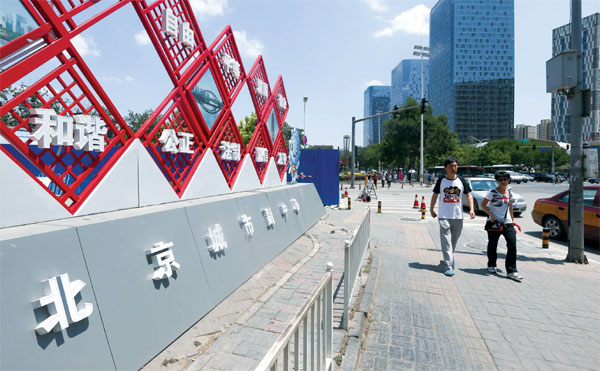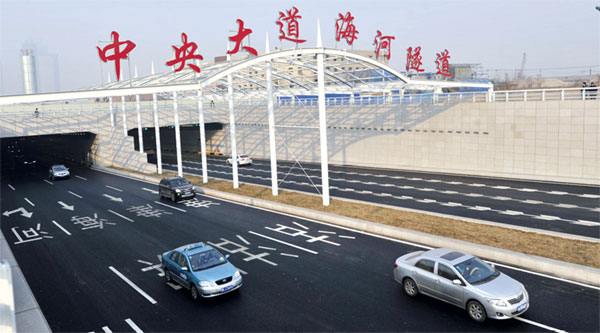Road map points the way forward for proposed industrial cluster

Officials have ratified an action plan to weld three major population centers into a single economic entity to promote stronger growth and tackle 'urban diseases'
The formation of a fully integrated world-class manufacturing and business hub in North China has moved a step closer after the governments of the three main centers involved accepted an official road map for the union.
The proposed Beijing-Tianjin-Hebei province cluster, which will have Beijing as its administrative center, will cover about 217,000 square kilometers and contain more than 200 counties and more than 100 million people. Last year, the combined GDP of the three centers was 6.65 trillion yuan ($1.07 trillion).
| Pedestrians walk past a sign in Tongzhou that reads, "Beijing Subsidiary Administrative Center". Hei Ke / China Daily |
| Cars pass through a tunnel under Tianjin's Haihe River. Xinhua |
Despite the move, Beijing will retain its role as China's capital and the national center for politics, culture, international exchanges and technical innovation.
At a recent conference to promote regional integration, Vice-Premier Zhang Gaoli said one of the priorities would be the smooth transfer of Beijing's non-capital functions to the outlying districts.
Zhang urged the three centers to implement the integration framework without delay, and called on them to provide detailed task lists and a timetable for full integration.
The authors of the road map combine and streamline the centers' own development plans to produce a unified strategy designed to optimize allocation of resources and promote stronger economic growth.
Moreover, when the 13th Five-Year Plan (2016-20) is implemented next year, Beijing, Tianjin and Hebei will follow a shared plan, instead of three separate approaches, the government says.
The three centers will play separate but interrelated, roles in boosting regional growth based on comprehensive analysis of their economies, current status, resources and other factors.
Relocation plans
According to the plan, a number of local government departments will relocate from downtown Beijing to the southeastern suburb of Tongzhou. Although the move will promote growth, some government employees are unhappy. One civil servant, who preferred not to be named, says she is considering quitting her job with the Beijing municipal government because the daily commute will be too time-consuming and stressful.
"It's too far to travel every day. Given the severe traffic congestion, the round trip would take three to four hours every day," says the 30-year-old who lives and works in southwestern Beijing. She adds that she plans to start a family next year, and complains that Tongzhou lacks good schools, hospitals and entertainment venues.
Huang Yan, deputy head of the Beijing Urban Planning Commission, says the relocations will be complex and will involve a great deal more than people simply selling their houses and moving to Tongzhou. She says the district would be transformed into an independent area, with a well-defined industrial structure and excellent entertainment and educational facilities.
Guo Jinlong, Party chief of Beijing, says the decision to promote the development of Tongzhou is an important step in the plan to move non-capital functions away from the center. He pledges that construction work would make "remarkable progress" by 2017.
Easing Beijing's burden
The relocations and deeper integration will help to ease some of the burden on the capital, which saw its population hit 21.5 million last year and is now faced with severe "urban diseases", such as heavily congested roads and environmental pollution.
Yu Zhongfu, a researcher at the office of the Beijing Party committee, says the transfer of industries and administrative departments provides effective, urgently needed ways of tackling the issues, and that the economic planning department is fully aware of the need to ease the pressures that result from unbalanced population growth.
According to Lu Yan, director of the Beijing Development and Reform Commission, four industrial sectors - general manufacturing, regional logistics and wholesale markets, parts of the education and healthcare industries, and some government departments and public institutions - will be relocated to Tongzhou, Tianjin and Hebei to tackle the problems of population growth and pollution.
The number of industries prohibited from operating in the capital's downtown area or working under strict regulation will also be increased, he says. About 79 percent of the major national industrial categories will eventually be prevented from operating in the six downtown districts, and the city will phase out around 1,200 polluting companies by 2017 to improve the environment.
Zhang Boxu, head of the Beijing Economy and Business Bureau, says, "Since 2014, Beijing has relocated more than 80 projects to Hebei province, with total investment reaching 120 billion yuan."
When the integration is complete, the annual value of goods produced in the new cluster could exceed 250 bill-ion yuan, providing a strong driver for the regional economy, he says.
According to the road map, one of the major aims of the integration program is the reduction of the capital's population. The authorities plan to have a maximum of 23 million people living in the downtown areas by 2020, which will require an annual reduction of 2 to 3 percent, leading to an overall decline of about 15 percent at the end of the five-year period.
However, Beijing has faced problems hitting its population targets this year. Lu Yan, from the economic planning department, says the capital's population grew by 1.7 percent in the first half of the year, and so far the relocation of industry has failed to reduce the downtown population as effectively as anticipated.
He says the city will redouble its efforts to control population growth by restricting illegal construction of homes and by issuing new household registration, or hukou, certificates to regulate the movement of large numbers of migrants to the city.
Despite the concerns about poor facilities and traffic congestion expressed by some employees, the authorities stress that work is underway to prepare Tongzhou for its new inhabitants.
Huang, from the Beijing Urban Planning Commission, says the government does not intend to build a "new" Tongzhou, but to upgrade the district by improving the transportation infrastructure and shaking up the urban planning process.
Experts say the measures will facilitate full integration, but they warn of potential pitfalls.
Pan Jiahua, director of the Institute of Urban and Environmental Studies at the Chinese Academy of Social Sciences, says the planners should be wary of creating "monocentric" cities, and should avoid an over-concentration of government departments in Tongzhou to prevent a sharp rise in the local population. He urges planners to consider other parts of the cluster as sites for relocation.
Outside of Beijing, Tianjin and Hebei have also outlined their development plans.
The authorities in Tianjin aim to transform the port city into a base for advanced manufacturing research and development. They also want to see the city become North China's international shipping hub, a mecca for financial innovation and services, and a pilot zone for economic reform.
Ye Tanglin, a researcher in regional integration at the Capital University of Economics and Business, says the developments would be a good fit for Tianjin and would fuel future growth.
Tianjin port is the third largest in China and the fourth largest in the world, which will facilitate the city's ambition to become an international shipping hub, Ye says.
However, he adds that the city must improve its use of neighboring ports, such as Huanghua and Caofeidian in Hebei, not as competitors, but as partners.
Business boost
Zhang Qingwei, the governor of Hebei, says the province - the largest and most populous in North China - will be the biggest contributor to the integrated cluster, but it will also benefit more than the two other members.
Its economy is weaker than that of Beijing and Tianjin, so the presence of many relocated industries would provide a much-needed boost for local businesses, he says.
According to a recent report in the 21st Century Business Herald, Hebei will be developed into a major logistics base, a pilot zone for industrial transformation and upgrades, urbanization and urban-rural integration, and a center for sustainable, eco-friendly development.
Ye, from the Capital University of Economics and Business, says the proposals make strategic sense and indicate future growth sources.
Hebei has also decided to promote regional industrial zones and develop satellite cities. A series of projects to upgrade regional transportation, industrial cooperation and environmental protection will start the ball rolling. The first of them, a railway connecting Baoding in Hebei and Tianjin, will be operational by the end of the year.
"This is a good time for us to grasp all the opportunities, to gain confidence and promote local businesses and trade. We must strike while the iron is hot," Governor Zhang says.
zhengjinran@chinadaily.com.cn

(China Daily European Weekly 08/07/2015 page16)
Today's Top News
- Japan tempting fate if it interferes in the situation of Taiwan Strait
- Stable trade ties benefit China, US
- Experts advocate increasing scope of BRI to include soft power sectors
- New engine powers cargo drone expansion
- China to boost green industry cooperation
- Manufacturing PMI rises in November
































